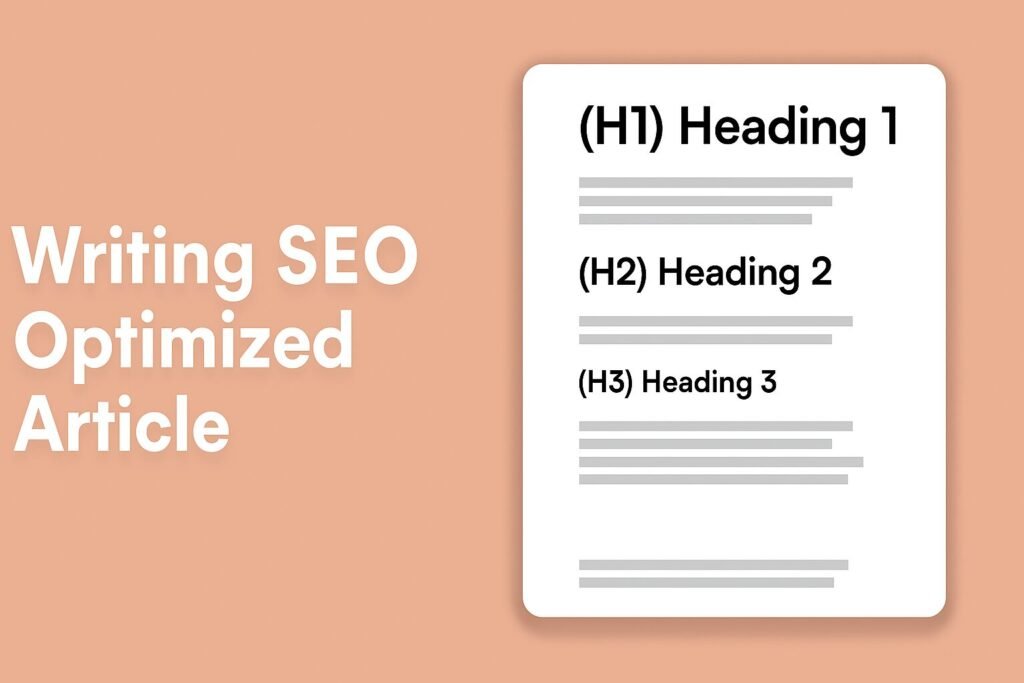
An SEO Optimized Article is more than just keyword-filled text — it’s a strategic blend of relevance, readability, and search intent. It helps your content appear where your audience is already looking, driving organic traffic and building trust. By combining semantic SEO, user experience, and data-driven structure, you can create articles that both inform and convert.
Businesses using optimized content strategies see up to 40% more traffic and leads (HubSpot). Whether you’re a blogger, marketer, or brand, mastering SEO writing ensures your message reaches the right people — and stays visible on Google for the long term.
Crafting one requires more than adding keywords. It’s about combining creativity, data, and optimization. Businesses that follow structured SEO writing can improve rankings by 34% faster (Backlinko). Let’s break down how to write content that both readers and search engines love.
What Is an SEO Optimized Article?
An SEO Optimized Article is designed to rank higher on Google by balancing user needs and algorithmic factors. It includes semantic SEO, keyword mapping, and structured content that satisfies both readability and relevance.
It focuses on topic depth, content optimization techniques, and intent-driven structure. When executed properly, it builds authority and drives long-term results through organic growth and sustained visibility.
Core elements of an SEO-friendly article
A successful article includes primary keywords, supporting LSI terms, optimized headers, and engaging visuals — all aligned with the topic’s purpose.
Why SEO optimization improves content visibility
Search-optimized content helps Google understand your topic’s context, boosting its chance of appearing in featured snippets or voice search results.
Understanding Search Intent Before You Write
Search intent defines why users search a term. Writing a successful SEO Optimized Article means knowing if readers want information, a product, or a service solution.
By matching intent, you create content that delivers value fast — increasing dwell time and improving user engagement signals like CTR and time-on-page.
Types of search intent (informational, navigational, transactional)
Identify what your audience seeks before writing. For instance, “how to write SEO content” is informational, while “best SEO writing services” is transactional.
Matching content with user expectations
Google rewards content that aligns with user expectations — using E-E-A-T principles: Experience, Expertise, Authoritativeness, and Trustworthiness.
How to Do Keyword Research for an SEO Optimized Article
Effective keyword research sets the foundation. Use Google Keyword Planner, Ahrefs, or SEMrush to identify relevant, low-competition terms that reflect your audience’s needs.
Focus on long-tail keywords and semantic clusters. For example, instead of “SEO article,” target “how to write SEO optimized article” for better intent matching.
Finding primary and secondary keywords
List your main keyword (focus keyword) and 3–5 supporting ones. Example: “SEO Optimized Article,” “SEO writing tips,” and “content optimization.”
Using keyword tools (Google Keyword Planner, Ahrefs, SEMrush)
These platforms reveal search volume, intent, and competition. Balance high-volume and niche phrases for stronger topical relevance.
Mapping keywords to headings and structure
Assign primary keywords to H2s and LSI terms to body sections for a natural flow and semantic coverage.
Structuring Your Article for Readability and SEO
Readers love clarity. Break content into short paragraphs, use descriptive headings, and insert visual aids where possible. An organized SEO Optimized Article helps Google crawl content faster and improves comprehension.
Use bullet points, tables, and numbered lists to enhance user experience. Example:
| Element | Purpose | Example |
|---|---|---|
| H2 | Topic clarity | “What is SEO?” |
| Bullet Points | Quick takeaways | “Use headings, visuals, CTAs” |
Ideal article layout (intro, body, conclusion)
Start with a strong hook, explain the topic deeply, and end with an actionable summary or CTA.
Importance of short paragraphs and clean formatting
Concise formatting boosts readability and user satisfaction, leading to longer on-page engagement.
Using bullet points, tables, and visuals effectively
Visuals like infographics or data charts increase dwell time and shareability.
Writing Compelling Titles and Meta Descriptions That Rank
Headlines create the first impression. A great SEO Optimized Article title includes the keyword, emotional trigger, and clarity.
For instance: “How to Write SEO Optimized Article That Ranks Fast in 2025.” This blends search intent, emotion, and precision.
Crafting click-worthy SEO titles
Use action verbs and numbers — “7 Proven Tips” performs 25% better than generic headlines (HubSpot).
Optimizing meta descriptions for higher CTR
Keep descriptions under 160 characters, add the focus keyword, and a compelling CTA to boost clicks.
Optimizing Headings, Paragraphs, and Keyword Placement
Strategic placement of your SEO Optimized Article keywords ensures relevance. Place the main keyword in the title, introduction, and 1–2 H2s naturally.
Avoid overstuffing. Google prefers content that reads smoothly, with semantic variations and natural flow.
Keyword density best practices
Aim for 0.8–1.5% keyword density, integrating LSI terms like “SEO writing,” “content optimization,” or “semantic relevance.”
Natural integration and semantic relevance (LSI keywords)
Use related phrases like E-E-A-T, search intent, or topic clustering to strengthen topical signals.
The Role of Internal and External Links in SEO Writing
Internal links help Google understand your site’s structure. Link new SEO Optimized Articles to older related posts for better crawl depth.
External links to credible sites like Google Search Central or Moz boost authority and EEAT.
Internal linking for user flow and ranking
Use anchor text that includes relevant semantic keywords. Example: “learn more about on-page SEO.”
External linking for authority and EEAT compliance
Reference trusted industry sources to validate claims — it builds trustworthiness and credibility.
Using Images, Alt Text, and Media to Boost SEO
Images enhance engagement but must be optimized. Use descriptive file names, alt text, and compression to speed up load times.
Well-optimized visuals improve content relevance and accessibility — vital ranking signals for Google.
Optimizing file names and alt attributes
Include descriptive alt text like “SEO Optimized Article example” for better image SEO.
How visuals enhance dwell time and engagement
Posts with visuals get 94% more views than text-only content (MDG Advertising).
Common SEO Writing Mistakes to Avoid (Tips from HA SEO Service)
Many writers misuse keywords or neglect intent. Avoid keyword stuffing, missing meta tags, and thin content. These mistakes reduce ranking potential and trust.
At HA SEO Service, we recommend using topic clustering, content briefs, and EEAT validation for every SEO project.
Keyword stuffing and over-optimization
Keep phrasing natural. Google’s algorithm detects forced repetition.
Ignoring readability and mobile experience
Mobile-first indexing means poor formatting hurts SEO — always test readability on small screens.
Final Checklist — How HA SEO Service Helps You Create SEO Optimized Articles That Rank
Creating high-performing content takes expertise. Our team at HA SEO Service uses data, psychology, and AI-assisted optimization to craft content that ranks.
We ensure every SEO Optimized Article meets Google’s standards for relevance, clarity, and authority.
Proven SEO writing workflow
Our process covers keyword research, on-page optimization, and performance tracking.
Tools and expert guidance from HA SEO Service
We use SurferSEO, Ahrefs, and Clearscope to enhance accuracy and performance metrics.
Frequently Asked Questions (FAQs)
1. How long should an SEO Optimized Article be?
Aim for 1,200–2,000 words for in-depth coverage and better ranking potential.
2. How many keywords should I use in one article?
Use one primary keyword and 3–5 supporting LSI phrases.
3. Do images affect SEO performance?
Yes. Optimized images improve load speed and visual engagement.
4. How often should I update my SEO content?
Review and refresh content every 3–6 months to maintain rankings.
5. Can I rank without backlinks?
Yes, but backlinks from authoritative domains greatly improve visibility and trust.
A well-written SEO Optimized Article combines research, structure, and authenticity. When you align your content with search intent and EEAT, results follow naturally.
Ready to scale your rankings? 🚀
Contact [HA SEO Service] today — let our experts craft SEO content that drives traffic, trust, and long-term business growth.
